The Final #EveryFrameOfEden Video Is Now Up!
The final #EveryFrameOfEden video is now up!
Thank you to everybody who took part! 💫 The web page with the full list of artist credits can be found here.
Slowed-down version under the cut:
More Posts from Thechangelingsea and Others
GWR: Does Jonathan have a mate?
Joe Hollins: In spite of his age, Jonathan still has good libido and is seen frequently to mate with Emma and sometimes Fred - animals are often not particularly gender-sensitive!
Source: Interview with Jonathan’s vet
Warding off the oncoming depressive episode by reading about very old tortoises

"Those who think listening isn't an art should see if they can do it half as well." - Michael Ende, Momo

Momo, also known as The Grey Gentlemen or The Men in Grey, is a fantasy novel by Michael Ende. The novel was published on January 1973.
“Calendars and clocks exist to measure time, but that signifies little because we all know that an hour can seem as eternity or pass in a flash, according to how we spend it.”
Michael Ende, Momo
Hey, Imogen here 🥰
I'm Imogell on X and Bluesky and I make Good Omens art ❤️
Please follow if you're into that. I want to find my friends here too! I'm trying to be more present here again, as well 🫂





Crowley found out that Aziraphale had put an extra bookshelf in the backroom of the bookshop on a measly Monday morning. When Muriel took him to the back and showed him the hidden cd collection behind a collection of books about dowdy fabric patterns they asked him whether he knew what the bookshelf was for. His breath hitched for a moment. Behind his glasses he blinked a couple of times. And he growled how the fuck should I know Muriel. He stalked off - looking his worst* murdery murderous look - slamming the bookshop door behind him, and hating the cheerful jingling with all his heart. Around the corner he relieved some of his feelings by shouting at some quivering nettles**.
It turned out that Aziraphale had co-opted Maggie's help in finding 'bebop' music. While Aziraphale did not really listen to that sort of music, he did have an extraordinary good memory. He had memorised many of the cd's Crowley had listened to. And collected them for some inexplicable reason. Crowley didn't get it. He didn't know why Aziraphale hadn't told him about this. He didn't get it. But he knew why of course.
Later that day he returned to the bookshop and slipped quietly into the backroom. He closed the door softly and took a deep breath. Smelling the dusty musty books always made him feel close to... He slowly ran a finger over the albums. Thinking back to those moments in the bentley listening together. Listening alone. Wondering. How long it would take for his angel to come back to him.
*so that means best depending how you look at it.
**The nettle, very confused and not having experienced demonic energies before, promptly grew a bright blue flower in between its pink ones. When Crowley saw that he stopped shouting and caressed the flower softly.

My latest Guardian Books cartoon. Inspired by this news story.
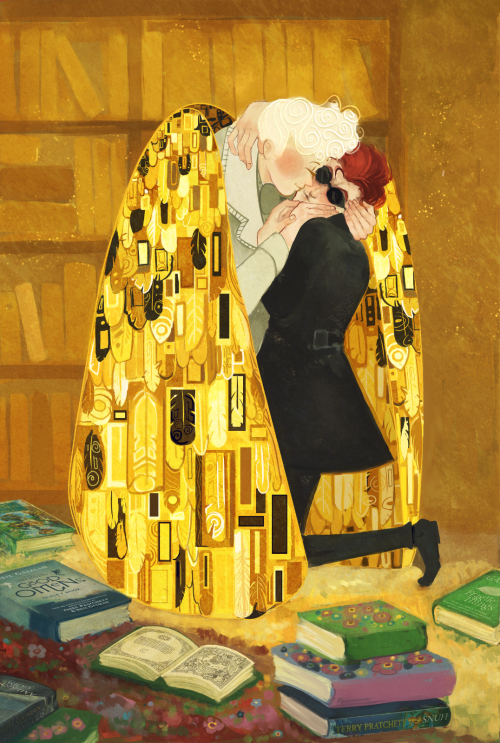
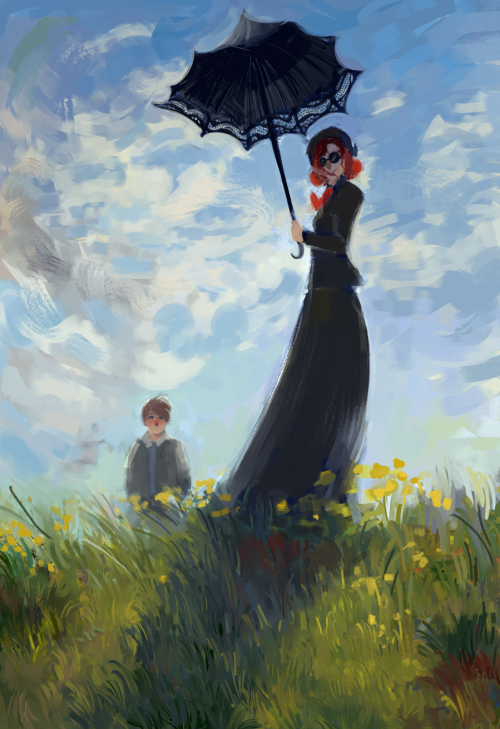
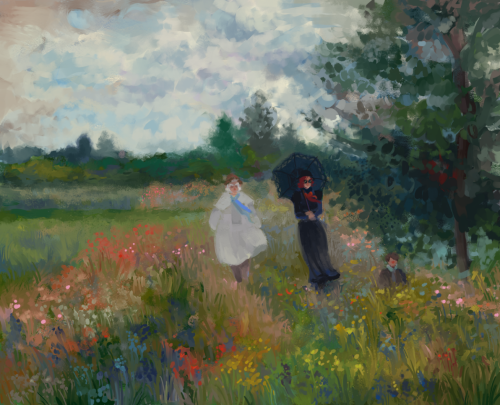

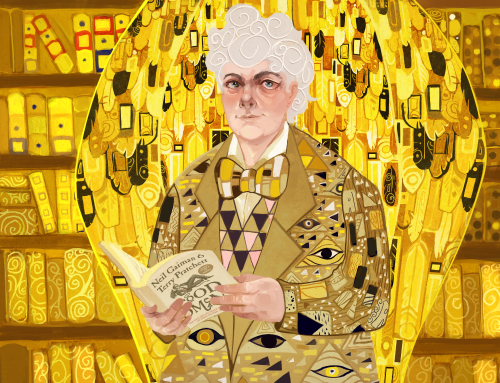
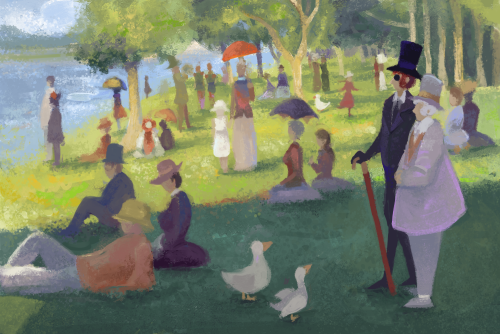
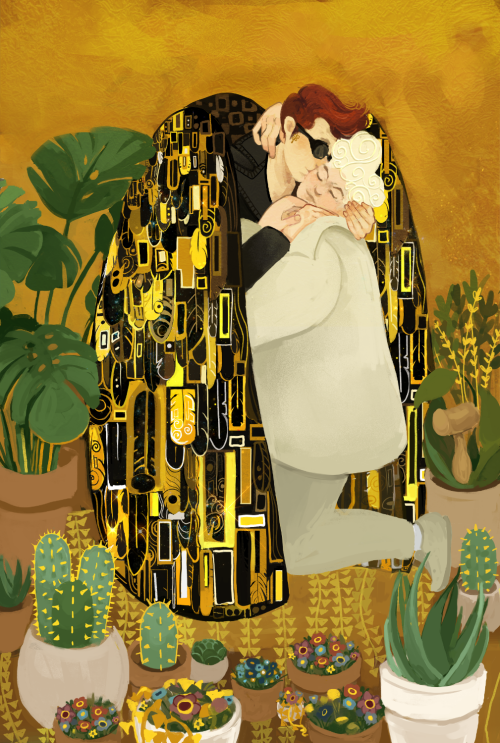
a compilation of all my planned good omens studies/recreations to commemorate finishing this project! they’ve been a great learning experience, and a bit of a trip down memory lane, though i must admit the monet ones are probably my favourite.
redbubble | society6
So unfortunately, Redbubble removed my Good Omens pieces, so if you’re interested in any of these pieces, please use my S6 link!




I really like the idea of Crowley changing up his wings every once in a while. Mostly just because I find a ridiculous amount of joy in drawing black wings with red lines. And I haven’t been able to get the idea of Crowley with albatross wings out of my head since first watching it, so I might as well throw in some others too.
None of these have good quality in the first place, but you can click the bottom ones to slightly improve what little there is
How to write horses (without making your characters stupid)
Lesson One: Riding Double
The first question to ask yourself is ‘is my character supposed to know what they’re doing or being taught by someone who does?’ If the answer is yes, this lesson is for you. If the answer is no and the character is supposed to not know about horses, then this lesson is also for you! Hooray accurate consequences!
(The second question is if you are dealing with realistic horses or fantasy ones. Because if your characters are in a far away world where horses are three times the size and strong enough to carry a literal ton? Idgaf go wild. Or are your horses magic and made of ice that can be summoned from thin air? Those can do whatever they want. But a real horse? They have real limitations.)
What is double riding and why is it a problem?
Double riding is just like it sounds- two people riding the same horse. It is commonly used in movies and television to keep actors in the same shot and to use less horses on set, but it is also used in video games, books, and animated media as well. And of course, sometimes people will ride double in real life as well, for brief occasions.
Without digging into some genuinely horrifying facts about equine anatomy, horses are really only built to carry a single rider in one specific place on their back. Saddles are used to distribute weight evenly and make everything more comfortable for both horse and rider, but they don’t increase the space available. Unless both riders are small enough to fit in the same saddle together, or the rider behind the saddle is very small, the horse will be overloaded. Riding double for long distances is NOT good for a horse, and any character that is supposed to understand horses will know this.
Let’s get some diagrams out.


So here is a horse (mine actually) and a skeleton of a horse so you can actually see inside.
From left to right, we start with the blue, which is the withers and shoulder blades.
The withers are bony processes up near the skin as part of the spine. They are not meant to have weight pressing directly down on them, and get sores very very quickly. A horse with sore withers obviously should not be ridden until it’s healed, and if ignored can lead to dangerous behaviors such as bucking or flipping over backwards.
The shoulders must be given freedom of movement and not be trapped by a saddle or the weight of a rider, in the case of riding double. If motion is limited, the entire horse can end up sore or worse
They’re like Christmas lights if you break one part the whole horse breaks
Next up is the green on my horse, the ribcage on the skeleton
This is the support area of the horse, where the strength of the back comes from. No weight should be placed beyond the attachment of the last rib
Again, not going into anatomy, but the entire chest and ribcage are held up by a sling of muscles, and the front legs are also only attached by muscles. However, these muscles hold up 70% of the horses bodyweight.
In general this is why saddle fit and rider positioning is very important- we’re adding our weight to an already complicated system
Finally the orange, the lumbar vertebrae.
This is the weakest point of a horses back by far, the lumbar spine
Just like the withers, these bones are very close to the surface and sore very easily if weight is placed on them.
Again, nothing heavy should ever be placed here.
This is also where the kidneys are, which are pretty important to the overall health of the horse and work best when they aren’t squashed
So. There’s your basic anatomy lesson. Let’s dig into riding double.

So here we go, some people sitting on my pony. Aren’t they beautiful?
The rider sitting in the saddle is in the optimal position for the horse to carry. Not too far forward, not too far back. Everything is dandy. The rider in the back, however, is sitting directly on the horses lumbar vertebrae. Even if the saddle pad extends that far for a little padding, the rider is still sitting directly on the lumbar spine.
I didn’t draw another rider, but having someone sit in the front of the saddle would be difficult for many reasons. For one, most saddles designed for long distance have a saddle horn, leaving nowhere to actually sit unless they’re somehow squeezed in between the main rider and the horn, or the main rider has slid back to sit more on the back of the saddle. (Neither are comfortable, trust me). For two, adding that much weight to the front of the saddle will overload the horses front and and cause pressure sores. And the legs of the double rider would have to hang down in front of the saddle, blocking the horses shoulders.
Basically- don’t have anyone sit there.
When riding double, the larger rider *always* must be the one sitting in the saddle. The lumbar spine can tolerate a child or small teenager for brief amounts of time, but *not* an adult. Absolutely not.

Here is the same picture with the riders removed, this time showing where pressure will be added.
Red I already covered above. Weight on the front of the saddle will cause sores on the withers and shoulders.
Green is someone sitting toward the back of the saddle. This will raise the front of the saddle up, adding pressure to the cinch under the belly that holds the saddle on. Cinch rubs can get very nasty very quickly, and a horse with cinch rubs and saddle sores should not be used again until they are healed.
This is *why* characters that understand horses would not ride double, especially if the horse is meant to be traveling a long way. You need to do everything you possibly can to keep the horse comfortable- make sure tack fits, saddle bags are balanced, and the rider is in the correct position in the saddle. Riding double throws all of that off, and it *will* cause long term damage if done repeatedly or for a long time. Horses are incredibly fragile creatures, even when given excellent care.
How do you avoid riding double?
Simple! Just add another horse to your story. Horses are herd animals and are more comfortable traveling in pairs than they are solo. If your characters aren’t worried about actually feeding the horse and just letting it eat grass the whole ride, there’s no added difficulty in having a second horse. Is one character riding out to go pick someone up? They can lead a second horse from the saddle (this is called ponying, btw), or a well trained horse can follow along loose.
As a morbid alternative, your characters can continue to ride double while understanding the consequences of this. Maybe the horse won’t make it all the way to their destination. Maybe it will arrive with sores and never be able to carry a rider again. Maybe your characters simply view their horse as transportation and are content to get a new one when the original is used up. It’s up to you, really.
And if your story is dependent on only having one horse or just them being on the same horse, that can be okay too. If the characters aren’t in a hurry, one of them can walk while the other rides. They can still use the one horse to escape a daring rescue. A character can hop from one horse to the other if their romantic ride is calling for a horseback makeout session. If the second rider is a child, or both are children, the single horse will do just fine. And of course, this is your story with a fictional horse. You can ignore all this and stick three riders on a horse for 500 miles straight with zero consequences if that’s what you really want to do. No one will stop you. This is only if you want your characters to read and act like they know their stuff. And I can assure you, irl riders everywhere will appreciate the effort.
I also wonder just now whether his name might mean something more to Crowley because Aziraphale gifted him with his name before the beginning, even though he (Crowley-as-an-angel) didn’t really register or reciprocate in that moment. I wonder if that moment is seared into Crowley’s memory now.
All the times Crowley calls Aziraphale by name - Chronological order
See also All the times Crowley calls Aziraphale "Angel" - Chronological order
















A few considerations. 1) After the Ark encounter, Crowley does call Aziraphale mainly 'Angel' over the centuries (Bildad, 1793, 1827, 1862) with one exception: 1827, when Wee Morag is dying and Crowley needs the angel to realize it's too late to heal her. Which is a major clue to the fact that calling him 'Aziraphale' could be a term of endearment. 2) Which may or may not be confirmed by the drunken scene after the fire: when Crowley sees the angel almost as a ghost, he says 'Aziraphale' - not 'Angel'. 3) After the Ark, considering the plot up to Season 1, the name 'Aziraphale' comes out when Crowley is calling after delivering the Antichrist (very formal occasion) and when Crowley is scared and/or angered (where are you, you idiot) or annoyed (kick butts, shoot him), 4) The Lockdown scene starts with a very sarcastic Crowley scolding the angel because he obviously knows it's 'Aziraphale' calling (again, annoyed), but it ends with the most heavenly 'Goodnight, Angel' after realizing he can't see him, yet. 5) As for Season 2, Crowley NEVER directly calls Aziraphale by name when they are alone together (see the very satisfying aformentioned 'Angel' compilation); however, when he's talking with other angels and/or demons he uses his first name - which is most convenient since they are more vulnerable around them. 6) The Us time they never got still breaks me.
In conclusion, I totally agree with @justdecadentcollectiondestiny (read this): There's probably a very good reason why Crowley stops calling Aziraphale 'Angel' after the bookshop fire - at least he stops until everything is over with Adam and Satan. I'm also sure there's a reason why Crowley refers to him only as 'Angel' throughout the whole second season (*Cough - quiet and gentle and romantic omens - *Cough). He felt safe enough; it was the time he dared to hope that the precious, peaceful, fragile existence would really work.
Of course, this is mere speculation. But the use of the two different names has meaning. This perfectionism (intended or unintended) delivers perfectly, and you can totally perceive the rollercoaster of Crowley's feelings for Aziraphale, from Eden to You're better than that.
As requested by @tremendouspostcoffee
-
 noxnightingales reblogged this · 2 months ago
noxnightingales reblogged this · 2 months ago -
 thelizerdwizerd liked this · 2 months ago
thelizerdwizerd liked this · 2 months ago -
 thelizerdwizerd reblogged this · 2 months ago
thelizerdwizerd reblogged this · 2 months ago -
 explosionartist reblogged this · 2 months ago
explosionartist reblogged this · 2 months ago -
 explosionartist liked this · 2 months ago
explosionartist liked this · 2 months ago -
 xu-444shn reblogged this · 2 months ago
xu-444shn reblogged this · 2 months ago -
 noko444 liked this · 2 months ago
noko444 liked this · 2 months ago -
 januarymedley liked this · 3 months ago
januarymedley liked this · 3 months ago -
 starryfull13 reblogged this · 3 months ago
starryfull13 reblogged this · 3 months ago -
 nosazabalus liked this · 3 months ago
nosazabalus liked this · 3 months ago -
 crowazira liked this · 3 months ago
crowazira liked this · 3 months ago -
 depressoespresso03 liked this · 4 months ago
depressoespresso03 liked this · 4 months ago -
 failsafetonull liked this · 4 months ago
failsafetonull liked this · 4 months ago -
 spac3-nugg3t liked this · 4 months ago
spac3-nugg3t liked this · 4 months ago -
 ultra-pea-on-a-cloud liked this · 4 months ago
ultra-pea-on-a-cloud liked this · 4 months ago -
 lydiablackblade reblogged this · 4 months ago
lydiablackblade reblogged this · 4 months ago -
 lydiablackblade liked this · 4 months ago
lydiablackblade liked this · 4 months ago -
 syntheticflavorings liked this · 4 months ago
syntheticflavorings liked this · 4 months ago -
 cleverpeanutfarmprune liked this · 4 months ago
cleverpeanutfarmprune liked this · 4 months ago -
 catabasis reblogged this · 4 months ago
catabasis reblogged this · 4 months ago -
 thelileggboy liked this · 4 months ago
thelileggboy liked this · 4 months ago -
 dcocca reblogged this · 4 months ago
dcocca reblogged this · 4 months ago -
 moralsofanalleycatsposts liked this · 4 months ago
moralsofanalleycatsposts liked this · 4 months ago -
 dcocca liked this · 4 months ago
dcocca liked this · 4 months ago -
 autistic-velociraptor liked this · 4 months ago
autistic-velociraptor liked this · 4 months ago -
 silentlovesongblog reblogged this · 4 months ago
silentlovesongblog reblogged this · 4 months ago -
 silentlovesongblog liked this · 4 months ago
silentlovesongblog liked this · 4 months ago -
 clacomat liked this · 4 months ago
clacomat liked this · 4 months ago -
 ladylivingforspite reblogged this · 4 months ago
ladylivingforspite reblogged this · 4 months ago -
 ladylivingforspite liked this · 4 months ago
ladylivingforspite liked this · 4 months ago -
 tigerowltattoos liked this · 4 months ago
tigerowltattoos liked this · 4 months ago -
 zeldahime reblogged this · 4 months ago
zeldahime reblogged this · 4 months ago -
 doctor-whoooo reblogged this · 4 months ago
doctor-whoooo reblogged this · 4 months ago -
 my-username-goes-here liked this · 4 months ago
my-username-goes-here liked this · 4 months ago -
 klikandtuna liked this · 4 months ago
klikandtuna liked this · 4 months ago -
 turnipwithatophat liked this · 4 months ago
turnipwithatophat liked this · 4 months ago -
 oxribs reblogged this · 4 months ago
oxribs reblogged this · 4 months ago -
 oxribs liked this · 4 months ago
oxribs liked this · 4 months ago -
 mirkwood-spider-express reblogged this · 4 months ago
mirkwood-spider-express reblogged this · 4 months ago -
 mangalpoddarofvarna liked this · 4 months ago
mangalpoddarofvarna liked this · 4 months ago -
 alrischapisces liked this · 4 months ago
alrischapisces liked this · 4 months ago -
 dragon-frootie liked this · 4 months ago
dragon-frootie liked this · 4 months ago -
 vinyama liked this · 4 months ago
vinyama liked this · 4 months ago -
 tehrenb reblogged this · 4 months ago
tehrenb reblogged this · 4 months ago -
 tehrenb liked this · 4 months ago
tehrenb liked this · 4 months ago -
 lashlamb13 liked this · 4 months ago
lashlamb13 liked this · 4 months ago -
 waitingtobebroken reblogged this · 4 months ago
waitingtobebroken reblogged this · 4 months ago -
 lickthecowhappy liked this · 4 months ago
lickthecowhappy liked this · 4 months ago -
 eraserhappy liked this · 4 months ago
eraserhappy liked this · 4 months ago -
 elenthyaolyenths liked this · 4 months ago
elenthyaolyenths liked this · 4 months ago

She/her, pan, ace, 40s | more silliness in my life please | (day)dreamer | voracious reader | music chaser
174 posts

